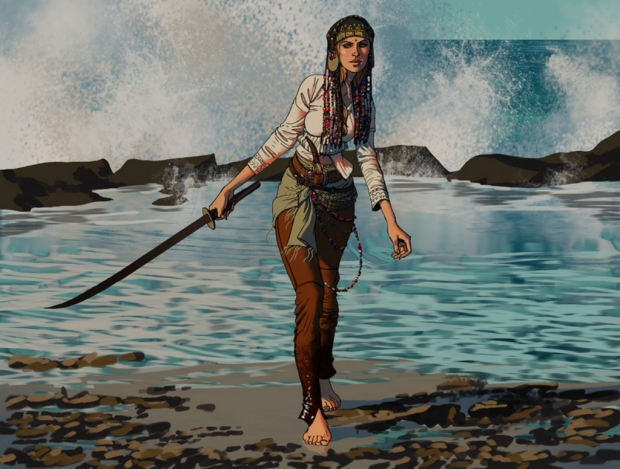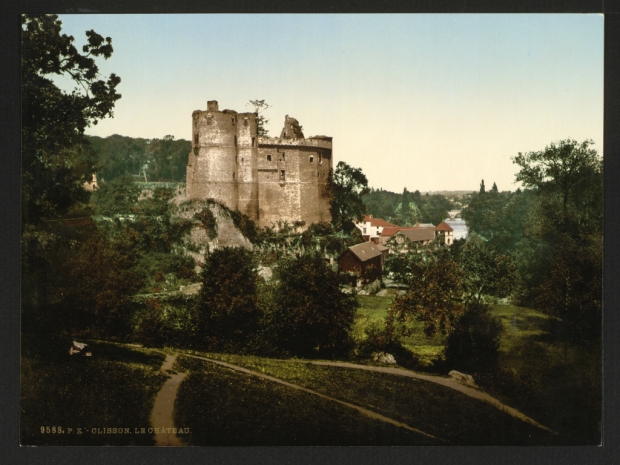Jeanne de Clisson: Lioness of Brittany and Female Privateer
Pillaging on land was not enough for the Lioness, who quickly took to the high seas.

Extrastory.cz | Jeanne de Clisson by Matt Rhodes
Flamboyant But Forgotten will be a regular column by contributor Rachel Cohen. In this column, Rachel will highlight some of the lesser-known historical figures whose backstories, personalities, and occupations make great fodder for creative fanfiction writing.
Since this is my first column about a historical figure who happens to be a woman (and a very interesting woman, at that), I can’t resist an introduction. It is a common (and unfortunate) view that women did not get to play particularly important roles in history. The fact is, this is just not so. In the Middle Ages, women were a major part of the landscape, even if their legal rights were laughable by today’s standards. Jeanne de Clisson (1300-1359) was one such woman. For starters, she terrified the King of France.
***
Jeanne Louise de Belleville was born in the year 1300, in the Belleville castle in the Loire Region of France (not to be confused with the Loire Valley, where the more famous castles are located). The spot is about 40 km west of the Atlantic coast – a couple of days’ journey to the shore. Therefore, I doubt very much that Jeanne grew up dreaming of sailing the high seas.
She also did not get to do much growing up. At twelve, she married a Breton nobleman, with whom she had two children and became a widow at twenty-six. She would have worn her hair braided, pinned up, and covered (as behooved a married woman). For undergarments, she would have worn a linen shirt, woolen stockings tied below the knee with garters, and nothing along the lines of what we call “panties” today. Over that, she would dress in a long gown called a cotte and a fur-lined cloak in cold weather. Since the 14th century marked the start of the European Little Ice Age, the temperatures would have been significantly colder than they are today. (Not that anybody would have referred to temperature at the time. They just dressed warmer.)

Library of Congress | Château de Clisson (1890)
At the age of thirty, the widowed Jeanne married Olivier de Clisson IV, a wealthy Breton. The remains of his castle, Château de Clisson, are still standing in France’s Loire region. While Jeanne was busy living her life, France and England were at war. The Hundred Years’ War, to be precise. Because of multiple French-English royal marriages, the blood lines became so tangled that the English kings could claim a right to the French throne. This was especially true if the French throne kept being vacated due to the deaths of kings without male heirs. When the French decided they wanted Aquitaine back, a southern part of France that belonged to England, war was declared.
Jeanne and Olivier de Clisson lived in the Duchy of Brittany. The Duchy, due to its history of being given over to the Norman invaders by early French kings, was actually independent of France and, thus, did not involve itself in the Hundred Years’ War. However, they decided to have a little war of their own. The Breton War of Succession happened because different claimants wanted to rule the Duchy, some of which were supported by France.

Wikimedia Commons | Execution of Olivier IV by Liédet
The Clissons actually sided against the English with the French choice for the crown. Olivier fought the invaders, but was captured defending the coastal city of Vannes. When the English released him for a ridiculously low ransom, the French suspected that Olivier was a traitor. He was invited to a tournament on French soil, where he was arrested, taken to Paris, tried, and beheaded in August 1343. (George R.R. Martin definitely gets his ideas from history.) Olivier’s body was left exposed and his head brought to the town of Nantes and mounted.
This is where the real story of Jeanne de Clisson begins: when she swore to avenge her husband’s murder. First, she took her two sons to Nantes to show them their father’s severed head. Next, she sold the de Clisson estates, raised a force of loyal men, switched allegiances to the English, and started attacking the French forces in Brittany. She would march her men on the castles whose masters supported the French choice for the crown, storm the stronghold, and massacre the inhabitants.
But pillaging on land was not enough for Jeanne. She and her two sons escaped by boat to England where, with the help of the English king, she procured three warships.

Wikimedia Commons | Battle of Sluys
This miniature from Jean Froissart’s Chronicles depicts the Battle of Sluys in 1340. Jeanne’s ships would have been quite similar, except the ships were painted black with dyed red sails. The three ships became known as “The Black Fleet” and Mme de Clisson as the “Lioness of Brittany.” She gave rise to a legend that is recounted in verse in Émile Péhant’s highly romanticised 19th century book Jeanne de Belleville.
Jeanne successfully pirated the English Channel for thirteen years. During the Hundred Years’ War’s Battle of Crecy, Jeanne used her ships to supply the English, which helped to decimate the French. The French king was said to go into a tizzy at the mention of the Jeanne’s name, but he ultimately failed to subdue her. Finally, in 1356, Jeanne retired to England, married for the third time an English noble favoured by the king, and died peacefully in her English castle three years later.
So that’s the short of it. If you ever wanted to write a Song of Ice and Fire fanfic, I think Jeanne de Clisson would fit right in.

This should become a movie,on Netflix.. This was real powerful woman
You want interesting women, I got interesting women:
Power Women of History
Lucy Stone – suffrage
Mabel Walker Willebrandt –
Prohibition AG
Laura Dewey Lynn Bridgman –
THE deaf and blind pioneer
Grace Hopper – Admiral
Ng Mui – Wing chun Kung fu
Tomoe Gozen – Samurai champion
Lena Sadler – Physician and activist
Elizabeth Jennings Graham – streetcar
Patricia Highsmith – Mystery novelist
Judy Holliday – actress
Great idea for a series, and a fun and informative first installment!
We agree! It’s fun to give the unknown and sidekick characters their time in the spotlight.